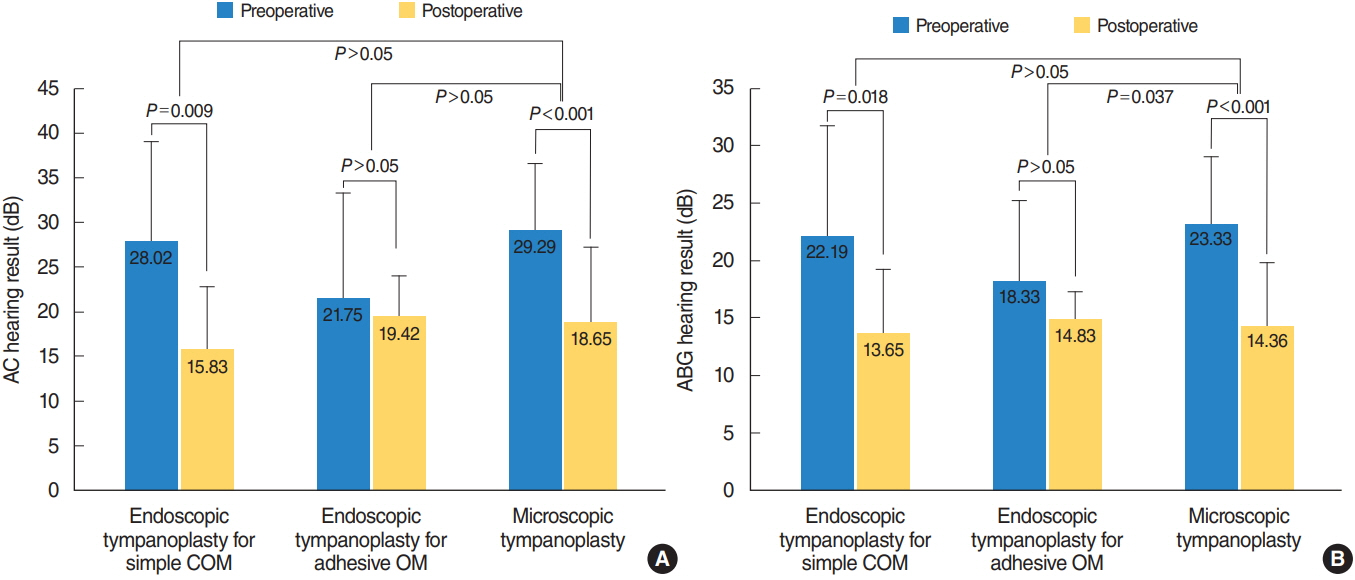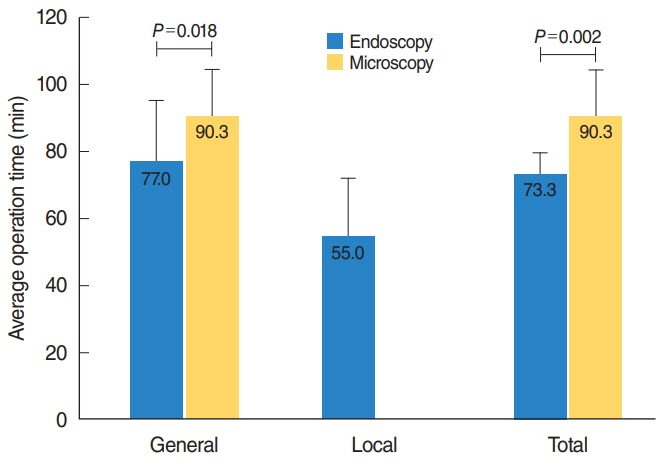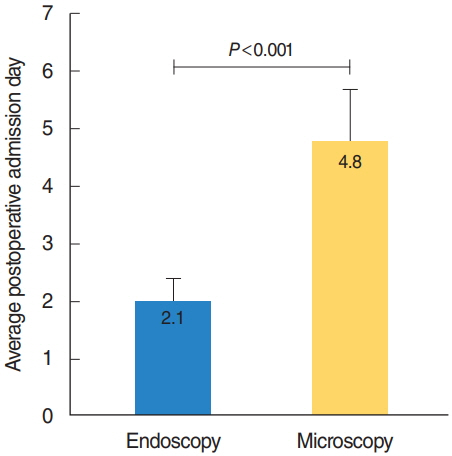Clin Exp Otorhinolaryngol.
2020 Feb;13(1):41-46. 10.21053/ceo.2019.00318.
Transcanal Endoscopic Tympanoplasty for Pediatric Patients Under 15 Years of Age With Chronic Otitis Media
- Affiliations
-
- 1Department of Otolaryngology-Head and Neck Surgery, Chonnam National University Hospital, Chonnam National University Medical School, Gwangju, Korea
- KMID: 2501296
- DOI: http://doi.org/10.21053/ceo.2019.00318
Abstract
Objectives
. To evaluate the results of transcanal endoscopic tympanoplasty for pediatric patients with chronic otitis media (COM) and compare them to that of the previously standard microscopic assisted tympanoplasty technique.
Methods
. The patients were divided into two groups based on the operative method. Group 1 underwent tympanoplasty with a totally endoscopic assisted technique (n=21, 24 ears), and group 2 underwent tympanoplasty with the conventional microscopic technique (n=14, 15 ears). We used a transcanal approach in group 1 and a postauricular approach in group 2. In group 1, there were 15 cases of simple COM and nine cases of adhesive otitis media. In group 2, only 15 cases of simple COM were present. We analyzed the outcomes in terms of the hearing gain according to the surgical method and COM type, operation time, hospital stay after surgery, and graft success rate.
Results
. Postoperative hearing gain results including air conduction (AC) thresholds and air-bone gap (ABG) were not significantly different between the two groups (P>0.05). In both the groups, significant improvement in the postoperative AC and ABG was observed compared to the preoperative hearing. The hospital stay after surgery was significantly shorter in group 1 than the group 2: 2.1±0.4 days and 4.8±0.9 days (P<0.001), respectively. The intact graft success rate was 91.6% in group 1 and 93% in group 2; the values were not significantly different (P>0.05). There was neither intra- nor postoperative complications.
Conclusion
. Transcanal endoscopic ear surgery technique is more conservative than microscopic approach and can be performed in pediatric patients under 15 years of age with COM. Moreover, it offers similar surgical results compared to traditional microscopic technique, and a shorter operative time and hospital stay after surgery are the advantages of this technique.
Figure
Reference
-
1. Wullstein H. Theory and practice of tympanoplasty. Laryngoscope. 1956; Aug. 66(8):1076–93.
Article2. Huang TY, Ho KY, Wang LF, Chien CY, Wang HM. A comparative study of endoscopic and microscopic approach type 1 tympanoplasty for simple chronic otitis media. J Int Adv Otol. 2016; Apr. 12(1):28–31.
Article3. Ozgur A, Dursun E, Erdivanli OC, Coskun ZO, Terzi S, Emiroglu G, et al. Endoscopic cartilage tympanoplasty in chronic otitis media. J Laryngol Otol. 2015; Nov. 129(11):1073–7.4. Kim HC, Cho WS, Seong JY, Jeon ES, Lee SS, Cho HH, et al. The efficacy of endoscopic exploratory tympanotomy in conductive hearing loss patients. Korean J Otorhinolaryngol-Head Neck Surg. 2017; 60(1):
Article5. Choi N, Noh Y, Park W, Lee JJ, Yook S, Choi JE, et al. Comparison of endoscopic tympanoplasty to microscopic tympanoplasty. Clin Exp Otorhinolaryngol. 2017; Mar. 10(1):44–9.
Article6. Badr-el-Dine M. Value of ear endoscopy in cholesteatoma surgery. Otol Neurotol. 2002; Sep. 23(5):631–5.
Article7. Thomassin JM, Korchia D, Doris JM. Endoscopic-guided otosurgery in the prevention of residual cholesteatomas. Laryngoscope. 1993; Aug. 103(8):939–43.
Article8. Raine CH, Singh SD. Tympanoplasty in children: a review of 114 cases. J Laryngol Otol. 1983; Mar. 97(3):217–21.
Article9. Black JH, Hickey SA, Wormald PJ. An analysis of the results of myringoplasty in children. Int J Pediatr Otorhinolaryngol. 1995; Jan. 31(1):95–100.
Article10. Aoki K. Advantages of endoscopically assisted surgery for attic cholesteatoma. Diagn Ther Endosc. 2001; 7(3-4):99–107.
Article11. Karhuketo TS, Ilomaki JH, Puhakka HJ. Tympanoscope-assisted myringoplasty. ORL J Otorhinolaryngol Relat Spec. 2001; Nov-Dec. 63(6):353–7.
Article12. James AL. Endoscope or microscope-guided pediatric tympanoplasty? Comparison of grafting technique and outcome. Laryngoscope. 2017; Nov. 127(11):2659–64.
Article13. Awad OG, Hamid KA. Endoscopic type 1 tympanoplasty in pediatric patients using tragal cartilage. JAMA Otolaryngol Head Neck Surg. 2015; Jun. 141(6):532–8.
Article14. Dundar R, Kulduk E, Soy FK, Aslan M, Hanci D, Muluk NB, et al. Endoscopic versus microscopic approach to type 1 tympanoplasty in children. Int J Pediatr Otorhinolaryngol. 2014; Jul. 78(7):1084–9.
- Full Text Links
- Actions
-
Cited
- CITED
-
- Close
- Share
- Similar articles
-
- Endoscopic Tympanoplasty
- A clinical study on the prognostic factors of tympanoplasty usingpostoperative tympanogram in chronic otitis media
- The Effect of Endoscopic Tympanoplasty on Cochlear Function
- Comparison of Hearing Results by Type of Tympanoplasty with Mastoid Obliteration during Chronic Otitis Media Surgery
- Surgery in the Only Hearing Ear





